|
| |
FAMILY ARANEIDAE
- This page contains pictures and information about St Andrew's Cross Spiders that we
found in the Brisbane area, Queensland, Australia.
-
 - Leg to leg female 50mm, female adult
-
- St Andrew's
Cross spiders are common in Brisbane bushes, backyard and gardens. They are easily recognized by the pattern on its body and its web. The
spiders build orb web, in the middle they put four thickened zigzag
strips in the shape of a cross of 'X'. The spider then hangs head
down with its legs pairs together over the cross. This is why it called
St Andrew's cross spider. Adult females build vertical orb web about 1m
in diameters and about 1-2 meters above ground. The spiders active both day and night.
-
-
Female
- Female St Andrew's
Cross spiders are very different from the males. Adult females grow to 15mm in
body length. The abdomen is flat oval shaped with transverse white, yellow
and reddish-brown stripes. The thorax and head are brownish-silver under sun
light.
-

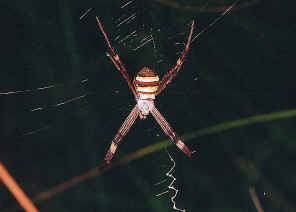 -
- All legs are brown in colour, with yellow bands at the middle.
-
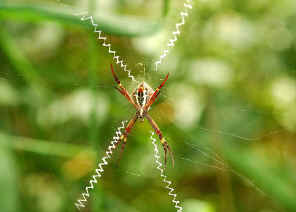
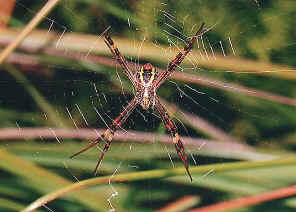 -
- On the bottom side of the abdomen there are the yellow lines around the
black patterns, with the spinnerets in reddish brown colour.
-
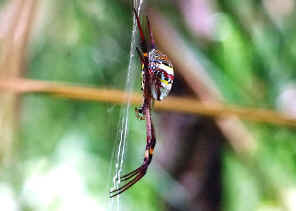
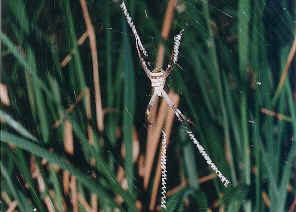
Male
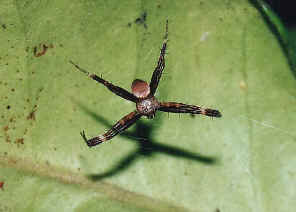 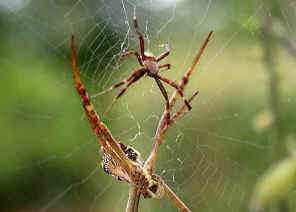 - Leg to leg 15mm, adult male
Male approaching a female
-
- Adult male St Andrew's Cross spiders
are much smaller than the adult female. They are dull brown in colour and with no
pattern on the abdomen. Both female and male St Andrew's Cross spiders have the hairy silver thorax and banded legs. All St Andrew's Cross spiders,
including male, young and matured female, rest with legs in pairs.
-
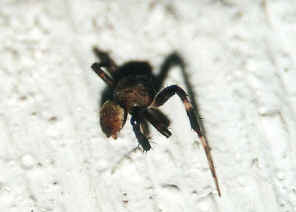 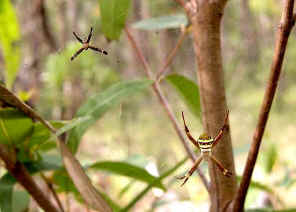 - Male with only four
legs
Male and female
-
- We occasionally found male St Andrew's Cross spider with
some legs loosed. The male in the above picture had only four legs left. He
could had just mated with a female. Although he was lucky enough to escape
after mating, half of its limbs were broken.
-
- When the males approach the females, they always stay on
the opposite face of the web and slip between the threads for the purpose of
mating.
Eggs
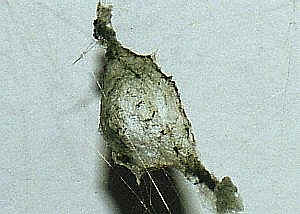 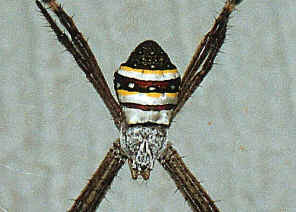 -
-
The
female lays her eggs in a silk sac which is close
to her web, then she will extract some liquid and dye the eggs sac into dark
green colour.
-
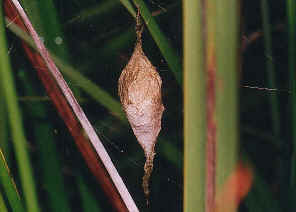
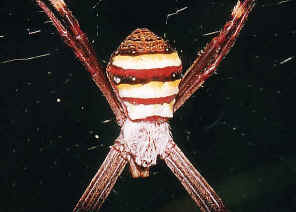
-
- Female makes her egg sacs on late summer to early winter. Usually a female
can make three or more egg sacs.
-
Juveniles
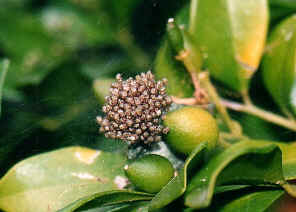 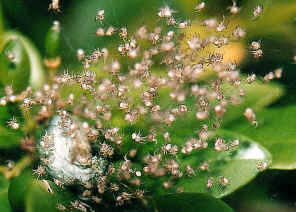 -
- From late winter to early spring, the young St Andrew's Cross Spiders
hatch from the egg sac. The young spiders will stay together outside the egg
sac for a few days. Then they will climb to a highest point and 'gone with the
wind' using the ballooning technique.
-
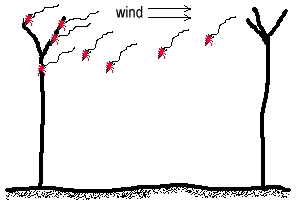 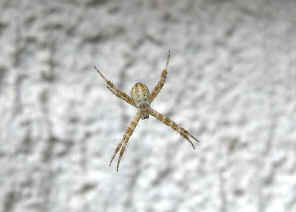 -
- Ballooning - A way that many species of spider used for travelling,
especially the young spiders. They hold a short length of silk which blowed by
the wing current. If the wind is strong enough, the young spiders travel with
the wind. By this way spiders can disturb very far away even within a
generation.
-
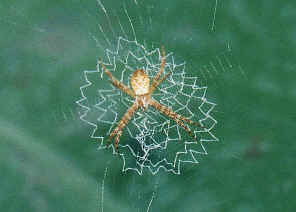 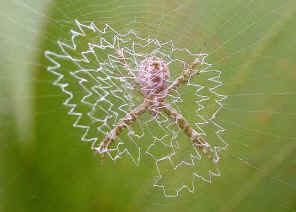 - Leg to leg 15mm, young
female
-
- Female St Andrew's Cross spiders are easily recognised by
theirs yellow bands on its flattened abdomen, with reddish-brown and white dots.
The patterns may be a little different for different individual. The young
female spiders are smaller in size, with same abdomen pattern although the
colours are paler than the adult female.
-
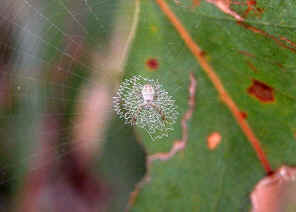
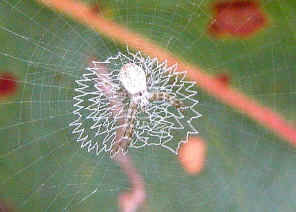 -
- From spring to mid summer we can found small spiders build web with
circular stabilimentum on lower plants. Their orb web is about 30cm in
diameter with circular stabilimentum, which make the web centre and the spider highly visible. They
are young St Andrew's Cross Spiders. They are pale brown to creamy white in
colour. As the spider grows the circular shape is gradually transformed into
cross shape.
-
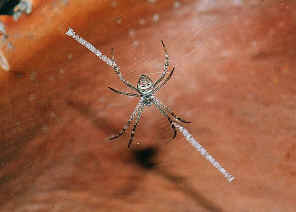
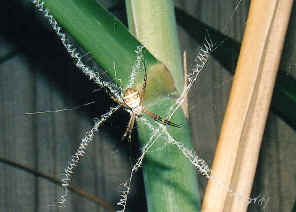 -
Leg to leg 20mm, elder young female
-
- Sometimes, the St Andrew's Cross
spider makes only one line. Sometimes, not very often, the spider
make two crosses.
- St Andrew's Cross spider and some other spiders
make this zigzag band known as stabilimentum.
-
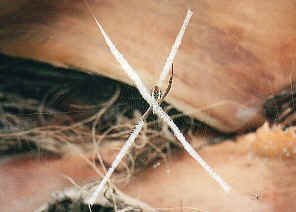 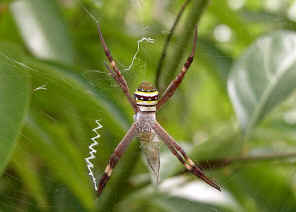 -
- The function of those stabilimentum is uncertain yet.
Some believed that the zigzag is used as the sign to warn-off the larger
animals. Some believed that it is to stabilize the web. Some suggested that it
acts as a sunshade. Some suggested a molting platform and other suggested they
are depository of surplus silk. Recently found that those ribbon silk
reflect ultra violet light which is attractive to flying insects. This is a typical type
of question in Evolution, it may never have a single proven answer. However,
usually more than
a single answer, or
even most answers are correct.
-
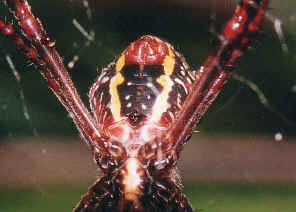 -
- A closer look at the silk spinnerets of St Andrew's Cross spider.
Sometimes the spider build really big cross. When disturbed, the spider will
either temporary drop to the ground (bungee jump with safety line) from the web
or shaking its web vigorously.
-
- Some orb web spiders, such as the Garden Orb Web
Spiders, only set up their web at night, the St Andrew's Cross spiders
set up their web for 24 hrs standby. However, they usually rebuild their web at
mid-night if necessary. In day time St Andrew's Cross spiders usually
repair (at minimum level) their webs if damaged.
-
- We discussed about how spiders use their silk in this page.
-
On bird's diet menu
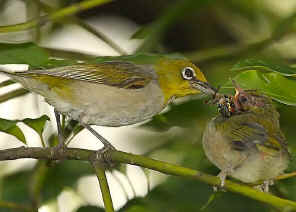 - Photo thank to Trevor Jinks, Gold Coast
-
- The bird is feeding a St Andrew's
Cross spider to its young.
-
- Reference:
- 1. Wildlife
of Greater Brisbane - Queensland Museum 1995, p35.
- 2. St.
Andrews Cross - The
Find-a-spider Guide for Australian Spiders, University of Southern
Queensland, 2007.
- 3. A Guide to Australian Spiders - Densey Clyne, Melbourne, Nelson
1969, p67 (Argiope aetherea).
- 4. Saint Andrew's Cross Spider - Spider Fact sheets, Australian Museum, 2003.
- 5. Australian Spiders in colour - Ramon Mascord, Reed Books Pty
Ltd, 1970, p76 (Argiope aetherea).
- Back to top
[ Up ] [ Garden Orb Web Spider ] [ Sliver Lobed Spider ] [ Brown Lobed Spider ] [ Scorpion-tailed Spider ] [ Leaf Nesting Spider ] [ Bush Orb Weaver ] [ Triangular Spider ] [ Triangular Spider II ] [ Tent Spider ] [ Russian Tent Spider ] [ Pan-web Spider ] [ St Andrew's Cross Spider ] [ Banded Orb-weaving Spider ] [ Gumtree Trunk Weaver ] [ Two-spined Spider ] [ Bird-dropping Spider ] [ Jewel Spider ] [ Wrap-around Spider ] [ Tree-stump Spider ] |





























